![]()
![]()
![]()
Use LEFT and RIGHT arrow keys to navigate between flashcards;
Use UP and DOWN arrow keys to flip the card;
H to show hint;
A reads text to speech;
95 Cards in this Set
- Front
- Back
|
Xray discovery (3) |
November 8th, 1895 Wilhelm Conrad Roentgen German |
|
|
You have to take ___ CEUs every ___ years |
12 2 |
|
|
Public Law 97-35 |
Minimum standards Consistent and safe procedures |
|
|
ASRT (2) |
American Society of Radiologic Technologist Basic Core of Knowledge and Skills |
|
|
Primary Radiation |
Radiation that leaves the tube before it hits anything |
|
|
Scatter radiation |
Results from primary xrays hitting something (usually patient) |
|
|
Remnant / exit radiation (2) |
Radiation that leaves the patient and strikes the IR Will make the image |
|
|
Detent |
What locks the tube to center of the bucky |
|
|
Bucky Tray (2) |
Holder for the IR Cassette Contains the grid |
|
|
Grid |
Used to absorb scatter |
|
|
ARLA |
As Low As Reasonably Achievable |
|
|
Time (1) Distance (4) ________ law When ____ is ____, _____ is reduced by factor of ___ Use correct _____ Sheilding (4) |
Time short
Distance inverse square law When distance is doubled, exposure is reduced by factor of 4 Use correct SID
Shielding
Personal Gonadal PersonalRoomXray tube Room Xray tube
|
|
|
NCRP (3) |
Sensitive body organs should be shielded Sheilding should never be a substitute for adequate beam collomation 0.5mm lead in sheild |
|
|
Personal Sheilding |
Lead aprons Lead gloves Thyroid sheilds Leaded glasses |
|
|
Primary Protective Barrier (lead ") Secondary Protective Barrier (lead ") |
1/16" 1/32" |
|
|
Tube Sheilding (2) |
Lead lined Protects patients and personnel from leakage radiation |
|
|
Personnel monitoring devices (3) |
OSLs TLDs Pocket Dosimeters |
|
|
OSL |
Aluminum oxide Worn at thyroid level If pregnant - secondary badge work at easte level under apron |
|
|
How to assist after recent back injury |
Have patient sit from Lateral recumbent position |
|
|
Patient position for nausea or short of breath |
Fowler Elevate upper body |
|
|
Patient position for abdominal pain |
Elevate head and bolster under knees |
|
|
Temperature |
Oral: 96.8 - 99.6 |
|
|
Pulse (2) |
60 - 100 bomb Tachycardia 110bpm |
|
|
Respiration |
12 - 20 |
|
|
Blood Pressure (2) |
50 - 99 diastolic 95 - 120 systolic Hypertension High BP 120 / 90 |
|
|
What is the main source of radiation |
Radon |
|
|
Units of exposure 3 units Each has a sub unit |
Roentgen (R) Air Kerma (Gya)
Rad GRAY (Gy)
Rem Silvery (Sv) |
|
|
Roentgen - R
Define |
Measurement of xray intensity in air |
|
|
Rad
Formula Stands for _______ Measures what? |
1 rad = .01 Gy
Radiation Absorbed Dose
Measurement of xray tissue |
|
|
Rem Formula Abv. Meaning Define |
1 rem = .01 Sv
Radiation Equivalent Man
Used for dose equivalent or occupational exposure
Rem = rem x QF |
|
|
R RAD REM FORMULA |
1R = 1 Rad = 1 Rem |
|
|
Total Equivalent Dose (EqD) Formula |
EqD = Absorbed Dose x Wr |
|
|
Equivalent Dose (EqD) Define (2) |
Uses quality factor based on type and energy of radiation
Whole body dose |
|
|
Effective Dose (EfD) Define (2)
|
Takes into account the type of radiation and type of tissue
Individual organ dose |
|
|
Conventional into SI FORMULA |
SI Unit = Conventuonal / 100 |
|
|
600 Rad is equivalent to ____ Gy |
600 rad /100 600 rad = 6Gy |
|
|
DAP (4) |
Dose Area Product
Determines the entire amount of energy delivered to the patient
Sum of air Kerma / exposed area of patient surface
Air Kerma Dose x area of irridated surface = DAP |
|
|
Law of Bergonié & Tribondeau (5) |
Age Differentiation Mitotic rate Metabolic rate Younger the cell - less differentiation, faster the mitosis/metabolic rate, more sensitive |
|
|
Somatic |
Short-term effects |
|
|
LD 50/30 ____-____ gy ____-_____ rad |
3 - 4 Gy 300 - 400 rad |
|
|
Erythema (2) |
Reddening of skin 200-1000 rad |
|
|
Reproductive cells (2) |
200 rad = temporary Sterility
500 rad = permanent sterility |
|
|
Somatic effects |
Long term effects |
|
|
Film Badge (3) |
Metal filters Film packet 1 month wear |
|
|
Pocket Ionization Chambers Pocket Dosimeter |
Most sensitive Immediate exposure readout Easy and conventional Accurate Expensive |
|
|
Thermoluminescent Dosimeters (TLD) |
Lithium Floride Crystals - They absorb radiation - headed and release energy as light 3 month wear Expensive |
|
|
OSL |
Long term Irridation stimulates electrons Aluminum oxide |
|
|
Lead apron thickness |
.55 mm |
|
|
KvP |
If KvP is changed, AEC will adjust exposure time accordingly |
|
|
mA |
If mA is changed, AEC will adjust the exposure time accordingly |
|
|
Annual Occupational Exposure Whole Body Dose |
5000 mrem
|
|
|
General Public Whole Body Dose |
100 mrem |
|
|
SID Indicator |
Must be within 2% of the indicated SID |
|
|
Filtration define |
Process of eliminating undesirable, low-energy photons Insertion of absorbing materials into primary beam |
|
|
Sagittal vs. Coronal plane |
Both vertical & mid Sagittal- forehead to back of head Coronal - ear to ear |
|
|
Radiography positions (4) |
Projection Position View Method |
|
|
Projection - types (8) |
AP PA Axil Tangential Lateral Oblique Complex True |
|
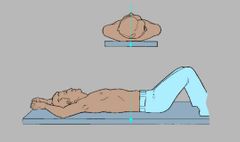
Type of projection |
AP Projection |
|
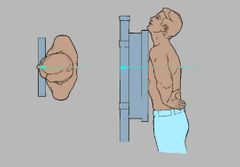
Type of Projection |
PA Projection |
|
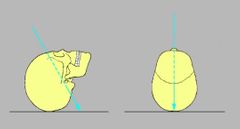
Projection type |
Axial Projection |
|
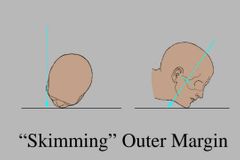
Projection type |
Tangential Projection |
|
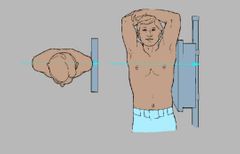
Projection Type |
Lateral Projection |
|
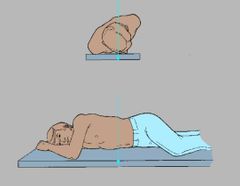
Projection Type |
PA Oblique Projection |
|
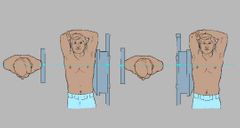
Projection type (2) |
1 Left Lateral 2 Right lateral |
|
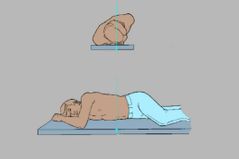
Position type |
RAO - Right Anterior Oblique |
|

Position type |
LPO - Left Posterior Oblique |
|
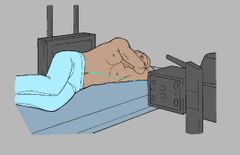
Position term |
Left Lateral Decubitus |
|
|
View vs. Projection Define + example |
Opposites PA projection = AP view |
|
|
# of cervical vertebrae # of thoracic vertebrae # of lumbar vertebrae |
7 12 5 |
|
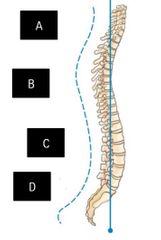
Label curvature & type of curves |
A. Cervical curvature -Concave & lordotic
B. Thoracic -convex
C. Lumbar Curvature -concave & lordotic
D. Sacral curvature -convex |
|
|
Kyphosis vs. Lordosis curves |
Kyphosis - increased convexity "humpback" Lordosis - increased concavity "swayback" |
|
|
AP Axial Central ray = Center IR to ____ |
Center IR to 4th Cervical vertebrae
Central ray - 15 - 20
Cephalad |
|
|
AP Axil - RPO / LPO (8) Turn patient ____° Chin = ____________ Central ray ____° IR entering at _______ intervertebral foramina is ________ from IR |
Turn patient 45° /straight ahead
Extend chin slightly
Cephalic
Central ray - 15°-20°
Entering at C4
Open intervertebral foramina FURTHEST from IR |
|
|
PA Axial Oblique Central ray ______° intervertebral foramina ______ to IR |
Central Ray - 15°-20°
Open intervertebral foramina CLOSEST to IR |
|
|
Lateral patient position
Patient facing how? Chin position? Shoulders - explain Respiration- ___________ Central ray = ___________ What needs to be captured in the xray |
Upright with L or R side against bucky
Elevate chin
Even shoulders - decompress
Respiration - suspended at end of expiration
Central Ray - perpendicular
ALL 7 VERTEBRAE & PART OF T1 |
|
|
Twinning method position
Patient position Arm/shoulder positioning - explain Central ray __________ Enter at ____ |
Upright with L or R side against bucky
Elevate arm closest to the IR, flex elbow, forearm on head, Depress shoulder
Respiration - suspended at end of expiration
Central Ray - perpendicular
T1 |
|
|
Zygapophyseal joints Location Lies at ___° angle to the _____ plane |
Joint space between superior articulating process and the inferior articulating process 70° , midsagittal |
|
|
Intervertebral foramen Location Lies at ___° angle to the _____ plane |
Space between inferior vertebral notch of vertebra and superior vertebral notch of vertebral below 90° , midsagittal |
|
|
Atomic number
What is it? Letter |
# of protons Z |
|
|
Atomic Mass Number Meaning Letter |
# of protons + # of neutrons A |
|
|
Alpha particles |
2 protons 2 neutrons |
|
|
Beta particles |
No mass -1 charge |
|
|
Xrays are produced where |
Outside the nucleus |
|
|
Wave theory Parts of the wave |
Wavelength Frequency Amplitude |
|
|
Wavelength Define Measured ____ to _____ |
Distance between any 2 successive points of a wave Crest to crest |
|
|
Aplitude Define |
Intensity of the wave Max height |
|
|
Frequency Define Measured by ____ Represented by ____ |
# of waves that passes a particular point in given time frame Hertz (Hz) Nu (v) |
|
|
Wave equation |
Velocity = (frequency)(wavelength) |
|
|
Speed of light = |
186,000 miles per second |
|
|
As frequency _______ wavelength _______ |
Increases Decreases |
|
|
As energy _______ wavelength ______ |
Increases Decreases |
|
|
Filament Define |
Small could of thin tungsten wire |
|
|
Radiographic qualities |
Photographic properties Density Contrast Geometric Recorded detail Distortion |
|
|
Milliamperage-second Formula |
mAs = mA x seconds |
|
|
Need at least _____% change in mAs |
25-50% |

